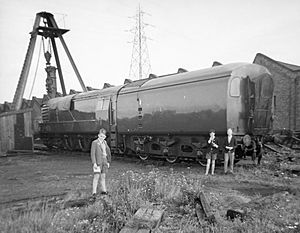Gas turbine locomotive facts for kids
A gas turbine locomotive is a special kind of locomotive (a train engine) that uses a powerful gas turbine engine to make it go. Think of a gas turbine like the engine in a jet airplane, but instead of pushing a plane through the air, it helps move a train along the tracks! These locomotives have been built in different ways. Some use the turbine's power directly to turn the wheels (this is called mechanical transmission). Others use the turbine to create electricity, which then powers electric motors that turn the wheels (this is called electric transmission).

Contents
How Do Gas Turbine Locomotives Work?
A gas turbine engine is like a big fan that sucks in air. This air is then squeezed (compressed) and mixed with fuel. When this mixture burns, it creates very hot, fast-moving gas. This hot gas spins a turbine, which is like a propeller with many blades.
The spinning turbine then does one of two things:
- Mechanical Drive: It can directly turn gears and shafts that connect to the train's wheels. This is similar to how a car engine works.
- Electric Drive: More commonly, the spinning turbine powers a generator. This generator makes electricity, just like a power plant. This electricity then goes to electric motors on the train's axles, making the wheels spin.
Why Use Gas Turbines for Trains?
Gas turbine engines are very powerful for their size. They can produce a lot of horsepower, which is great for moving heavy trains or making them go very fast. They also tend to be smoother than traditional diesel engines because they have fewer moving parts.
However, they also have some downsides. They can use a lot of fuel, especially when going slowly. They can also be quite noisy.
History of Gas Turbine Locomotives
People have been experimenting with gas turbine locomotives for many years. The idea was to create a powerful and efficient train engine.
Early Experiments
One of the first gas turbine locomotives was built in Switzerland in 1941. It was an experimental train that used a gas turbine to generate electricity. It showed that the idea could work, but it wasn't very fuel-efficient.
In the United States, the Union Pacific Railroad became famous for using gas turbine locomotives. They needed very powerful engines to pull long, heavy freight trains over mountains.
Union Pacific's "Big Blows"
Union Pacific started using gas turbine-electric locomotives in the 1950s. These were huge, powerful machines that earned the nickname "Big Blows" because of the loud noise their turbines made. They were designed to burn cheap heavy fuel oil.
Union Pacific had three generations of these locomotives:
- First Generation (1952-1954): These were 4,500 horsepower units. They were often used in pairs to get enough power.
- Second Generation (1954-1956): These were also 4,500 horsepower, but they were built differently.
- Third Generation (1958-1961): These were the most powerful, with 8,500 horsepower from a single turbine. They were some of the most powerful locomotives ever built!
These "Big Blows" were very good at pulling heavy trains. However, the price of fuel oil went up, and maintaining them became expensive. By the early 1970s, Union Pacific stopped using them.
Other Countries and Passenger Trains
Other countries also tried gas turbine locomotives.
- Great Britain: The British Rail GT3 was an experimental locomotive built in the 1960s. It used a gas turbine with a mechanical transmission.
- France: France developed successful "Turbotrains" for passenger service in the 1970s. These trains were fast and comfortable, especially on non-electrified lines. They were used for many years.
- Canada and the USA: The TurboTrain was also used in Canada and the United States for passenger service. It was known for its sleek design and high speed.
Modern Developments
Today, most trains use diesel or electric power. However, some new gas turbine locomotives have been built for special purposes, like the GT1h in Russia. These modern designs try to be more fuel-efficient and quieter than older models.
Gas turbine locomotives are an interesting part of railway history. They show how engineers tried to find new ways to make trains faster and more powerful.
Images for kids
-
British Rail APT-E, Derby, UK, 1972
-
First generation GTEL and a 1923 electric auto in Fremont, Nebraska in 1953
-
An RTG Turboliner at Union Station, St. Louis, in the 1970s













